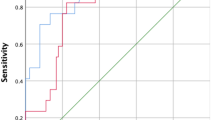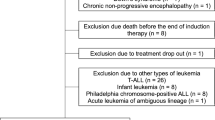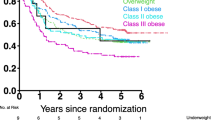Abstract
Changes in body composition, in particular the onset of obesity, may result from reductions in total daily energy expenditure (TDEE) as a consequence of relative physical inactivity. Children previously treated for acute lymphoblastic leukemia (ALL) become obese, yet the mechanism remains undefined. TDEE and physical activity levels [PAL = TDEE/basal metabolic rate(BMR)] were measured in 34 long-term survivors of ALL and compared with results from 21 survivors of other malignancies and 32 healthy sibling control subjects using the flex-heart rate technique. Body composition was measured by dual energy x-ray absorptiometry. The median TDEE was reduced in the ALL group(150 kJ·kg d-1) compared with other malignancies and controls(207 and 185 kJ·kg d-1, respectively, p < 0.01). This reduction was accounted for mainly by a relative decrease in the PAL of the ALL group (1.24) compared with both other malignancies and controls (1.58 and 1.47, respectively, p < 0.01). TDEE and PAL were correlated with percentage body fat (r = -0.39, p < 0.001 and r = -0.24, p < 0.05, respectively). Obesity in survivors of ALL may, in part, be explained by a reduction in TDEE as a consequence of reduced PAL. The cause of such reduction is uncertain.
Similar content being viewed by others
Log in or create a free account to read this content
Gain free access to this article, as well as selected content from this journal and more on nature.com
or
Abbreviations
- ALL:
-
acute lymphoblastic leukemia
- BMI:
-
body mass index
- BMR:
-
basal metabolic rate
- CI:
-
confidence interval
- DEXA:
-
dual energy x-ray absorptiometry
- FFM:
-
fat free mass
- HR:
-
heart rate
- PAL:
-
physical activity level
- RMR:
-
resting metabolic rate
- TDEE:
-
total daily energy expenditure
- NHL:
-
non-Hodgkin's lymphoma
- SDS:
-
SD score
References
Jenney ME, Kane RL, Lurie N 1995 Developing a measure of health outcomes in survivors of childhood cancer: a review of the issues. Med Pediatr Oncol 24: 145–153.
Odame I, Reilly JJ, Gibson BES, Donaldson MDC 1994 Patterns of obesity in boys and girls after treatment for acute lymphoblastic leukaemia. Arch Dis Child 71: 147–149.
Van Dongen-Melman JEWM, Hokken-Koelega ACS, Hählen K, De Groot A, Tromp CG, Egeler RM 1995 Obesity after successful treatment of acute lymphoblastic leukemia in childhood. Pediatr Res 38: 86–90.
Didi M, Didcock E, Davies HA, Ogilvy-Stuart AL, Wales JKH, Shalet SM 1995 High incidence of obesity in young adults after treatment of acute lymphoblastic leukemia in childhood. J Pediatr 127: 63–67.
Zee P, Chen CH 1986 Prevalence of obesity in children after therapy for lymphoblastic leukemia. Am J Pediatr Hematol Oncol 8: 294–299.
Wilmore JH 1996 Increasing physical activity: alterations in body mass and composition. Am J Clin Nutr 63 ( suppl): 456S–460S.
Steptoe A, Butler N 1996 Sports participation and emotional well being in adolescents. Lancet 347: 1789–1792.
Eden OB, Lilleyman JS, Richards S, Shaw MP, Peto J 1991 Results of Medical Research Council Leukaemia Trial UKALL VIII (report to the Medical Research Council on behalf of the working party on leukaemia in childhood). Br J Haematol 78: 187–196.
Chessells JM, Bailey CC, Richards S 1992 MRC UKALL X. The UK protocol for childhood ALL: 1985-1990. The Medical Research Council working party on childhood leukaemia. Leukaemia 6 ( suppl 2): 157–161.
Ravussin E, Bogardus C 1989 Relationship of genetics, age, and physical fitness to daily energy expenditure and fuel utilization. Am J Clin Nutr 49: 968–975.
Weir JB deV 1949 New methods for calculating metabolic rate with special reference to protein metabolism. J Physiol 109: 1–9.
Warner JT, Bell W, Webb DKH, Gregory JW 1997 Relationship between cardiopulmonary response to exercise and adiposity in survivors of malignancy. Arch Dis Child 76: 298–303.
Freeman JV, Cole TJ, Chinn S, Jones PRM, White EM, Preece MA 1995 Cross sectional stature and weight reference curves for the UK, 1990. Arch Dis Child 73: 17–24.
Cole TJ, Freeman JV, Preece MA 1995 Body mass index reference curves for the UK. 1990. Arch Dis Child 73: 25–29.
Poehlman ET, Toth MJ 1995 Mathematical ratios lead to spurious conclusions regarding age- and sex-related differences in resting metabolic rate. Am J Clin Nutr 61: 482–485.
Schell MJ, Ochs JJ, Schriock EA, Carter M 1992 A method of predicting adult height and obesity in the long-term survivors of childhood acute lymphoblastic leukemia. J Clin Oncol 10: 128–133.
Warner JT, Gregory JW, Webb DKH 1995 Patterns of obesity in boys and girls after treatment for acute lymphoblastic leukaemia. Arch Dis Child 72: 97
Ceesay SM, Prentice AM, Day KC, Murgatroyd PR, Goldberg GR, Scott W, Spurr GB 1989 The use of heart rate monitoring in the estimation of energy expenditure: a validation study using indirect whole-body calorimetry. Br J Nutr 61: 175–186.
Schulz S, Westerterp KR, Brück K 1989 Comparison of energy expenditure by the doubly labeled water technique with energy intake, heart rate, and activity recording in man. Am J Clin Nutr 49: 1146–1154.
Spurr GB, Prentice AM, Murgatroyd PR, Goldberg GR, Reina JC, Christman NT 1988 Energy expenditure from minute-by-minute heart-rate recording: comparison with indirect calorimetry. Am J Clin Nutr 48: 552–559.
Livingstone MBE, Prentice AM, Coward WA, Ceesay SM, Strain JJ, McKenna PG, Nevin GB, Barker ME, Hickey RJ 1990 Simultaneous measurement of free-living energy expenditure by the doubly labelled water method and heart-rate monitoring. Am J Clin Nutr 52: 59–65.
Livingstone MBE, Coward WA, Prentice AM, Davies PSW, Strain JJ, McKenna PG, Mahoney CA, White JA, Stewart CM, Kerr M-JJ 1992 Daily energy expenditure in free-living children: comparison of heart-rate monitoring with doubly labeled water (2H218O) method. Am J Clin Nutr 56: 343–352.
Panter-Brick C, Todd A, Baker R, Worthman C 1996 Comparative study of flex heart rate in three samples of Nepali boys. Am J Hum Biol 8: 653–660.
Panter-Brick C, Todd A, Baker R, Worthman C 1996 Heart rate monitoring of physical activity among village, school, and homeless Nepali boys. Am J Hum Biol 8: 661–672.
Emons HJG, Groenenboom DC, Westerterp KR, Saris WHM 1992 Comparison of heart rate monitoring with indirect calorimetry and the doubly labelled water (2H218O) method for the measurement of energy expenditure in children. Eur J Appl Physiol 65: 99–103.
Bradfield RB 1971 A technique for determination of usual daily energy expenditure in the field. Am J Clin Nutr 24: 1148–1154.
Chaitman B 1992 Exercise stress testing. In: Braunwald E(eds) A Textbook of Cardiovascular Medicine, 4th Ed. WB Saunders, Philadelphia, pp 161–179.
Flamm SD, Taki J, Moore R, Lewis SF, Keech F, Maltais F, Ahmed M, Callahan R, Dragotakes S, Alpert N 1990 Redistribution of regional and organ blood volume and effect on cardiac function in relation to upright exercise intensity in healthy human subjects. Circulation 81: 1550–1559.
Bu'Lock FA, Mott MG, Oakhill A, Martin RP 1995 Left ventricular diastolic function after anthracycline chemotherapy in childhood: relation with systolic function, symptoms, and pathophysiology. Br Heart J 73: 340–350.
Lipshultz SE, Colan SD, Gelber RD, Perez-Atayde AR, Sallan SE, Sanders SP 1991 Late cardiac effects of doxorubicin therapy for acute lymphoblastic leukemia in childhood. N Engl J Med 324: 808–815.
Klewer SE, Goldberg SJ, Donnerstein RL, Berg RA, Hutter JJ 1992 Dobutamine stress echocardiography: a sensitive indicator of diminished myocardial function in asymptomatic doxorubicin-treated long-term survivors of childhood cancer. J Am Coll Cardiol 19: 394–401.
Weesner KM, Bledsoe M, Chauvenet A, Wofford M 1991 Exercise echocardiography in the detection of anthracycline cardiotoxicity. Cancer 68: 435–438.
Li R, Deurenberg P, Hautvast JGAJ 1993 A critical evaluation of heart rate monitoring to assess energy expenditure in individuals. Am J Clin Nutr 58: 602–607.
Nevill AM, Ramsbottom R, Williams C 1992 Scaling physiological measurements for individuals of different body size. Eur J Appl Physiol 65: 110–117.
Food and Agricultural Organisation World Health Organisation United Nations University 1985 Report of a joint expert consultation. Energy and protein requirements. WHO Tech Rep Ser 724: 194–195.
Jenney MEM, Faragher EB, Morris-Jones PH, Woodcock A 1995 Lung function and exercise capacity in survivors of childhood leukaemia. Med Pediatr Oncol 24: 222–230.
Blaak EE, Westerterp KR, Bar-Or O, Wouters LJM, Saris WHM 1992 Total energy expenditure and spontaneous activity in relation to training in obese boys. Am J Clin Nutr 55: 777–782.
Bandini LG, Schoeller DA, Dietz WH 1990 Energy expenditure in obese and nonobese adolescents. Pediatr Res 27: 198–203.
Maffeis C, Schutz Y, Zaffanello M, Piccoli R, Pinelli L 1994 Elevated energy expenditure and reduced energy intake in obese prepubertal children: paradox of poor dietary reliability in obesity?. J Pediatr 124: 348–354.
Bradfield RB, Paulos J, Grossman L 1971 Energy expenditure and heart rate of obese high school girls. Am J Clin Nutr 24: 1482–1488.
Armstrong N, Balding J, Gentle P, Kirby B 1990 Patterns of physical activity among 11 to 16 year British children. BMJ 301: 203–205.
Crowne EC, Moore C, Wallace WHB, Ogilvy-Stuart AL, Addison GM, Morris-Jones PH, Shalet SM 1992 A novel variant of growth hormone(GH) insufficiency following low dose cranial irradiation. Clin Endocrinol 36: 59–68.
Acknowledgements
The authors thank R. Tong (Section of Exercise Physiology, University of Wales Institute, Cardiff) for assistance in collection of the exercise data, J. H. Pearse (Department Medical Physics, University Hospital of Wales, Cardiff) for performing the DEXA scans, and Dr. F. D. J. Dunstan (Department of Medical Statistics, University of Wales College of Medicine, Cardiff) for statistical advice. Finally we thank the children and their parents for participating and making the study possible.
Author information
Authors and Affiliations
Additional information
Supported by a grant from the local childhood oncology charity, Llandough Aims to Treat Children with Cancer and Leukaemia with Hope (LATCH) (to J.T.W.). Support was also provided by Pharmacia and Upjohn.
Rights and permissions
About this article
Cite this article
Warner, J., Bell, W., Webb, D. et al. Daily Energy Expenditure and Physical Activity in Survivors of Childhood Malignancy. Pediatr Res 43, 607–613 (1998). https://doi.org/10.1203/00006450-199805000-00008
Received:
Accepted:
Issue date:
DOI: https://doi.org/10.1203/00006450-199805000-00008
This article is cited by
-
Physical activity and fitness among pediatric cancer survivors: a meta-analysis of observational studies
Supportive Care in Cancer (2019)
-
The effect of autonomic nervous system dysfunction on oxygen consumption during daily living activities in patients with spinal cord injury
Spinal Cord (2017)
-
EXERCISE in pediatric autologous stem cell transplant patients: a randomized controlled trial protocol
BMC Cancer (2012)
-
High incidence of fatty liver and insulin resistance in long-term adult survivors of childhood SCT
Bone Marrow Transplantation (2011)
-
Design of the Quality of Life in Motion (QLIM) study: a randomized controlled trial to evaluate the effectiveness and cost-effectiveness of a combined physical exercise and psychosocial training program to improve physical fitness in children with cancer
BMC Cancer (2010)



